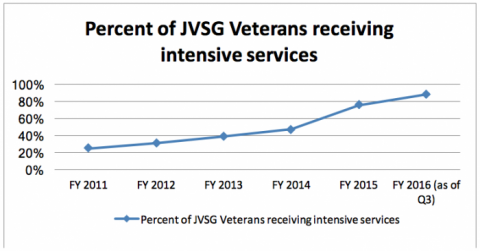- Home
- Agencies
- Department of Agriculture
- Department of Housing and Urban Development
- General Services Administration
- Department of Commerce
- Department of the Interior
- National Aeronautics and Space Administration
- Department of Defense
- Department of Justice
- National Science Foundation
- Department of Education
- Department of Labor
- Office of Personnel Management
- Department of Energy
- Department of State
- Small Business Administration
- Environmental Protection Agency
- Department of Transportation
- Social Security Administration
- Department of Health and Human Services
- Department of the Treasury
- U.S. Agency for International Development
- Department of Homeland Security
- Department of Veterans Affairs
- Goals
- Initiatives
- Programs
Improved employment outcomes for veterans
What’s the Issue?
As large numbers of service members and veterans return to the civilian labor force, they are met by an improving but still-challenging labor market. Some veterans, service members, and their families still face significant barriers to entering and maintaining meaningful employment. This is especially true for veterans with a service-connected disability, the educationally or economically disadvantaged, and veterans ages 18 - 24, who have experienced historically high unemployment.
What was the intervention?
The Veterans’ Employment and Training Service (VETS) issued guidance to ensure appropriate targeting of Jobs for Veterans State Grants (JVSG) funding. VETS and the Employment and Training Administration (ETA) released joint guidance in April 2014, to ensure targeting of the JVSG program to veterans with significant barriers to employment. Prior to this change, many states were referring all veterans in AJCs to the JVSG program. The Jobs for Veterans State Grant (JVSG) program provides funding to 54 states and territories for Disabled Veterans’ Outreach Program (DVOP) specialists and Local Veterans’ Employment Representative (LVER) staff, located in American Job Centers. DVOP specialists provide intensive services to veterans and eligible populations, including homeless and formerly incarcerated veterans, through individualized case management. This includes comprehensive and specialized assessments of skill levels and needs, development of individual employment plans, group and individual career counseling and planning, and short-term skills development (such as interview and communication skills). LVER staff promotes the hiring of veterans in communities through outreach activities that build relationships with local employers and provides training to workforce center staff to facilitate the provision of services to veterans.
How was performance management useful?
The Department made the provision of intensive services to veterans with a significant barrier to employment an Agency Priority Goal (APG) for FY12-13, FY14-15 and FY 16-17. VETS committed to raising the rate of intensive services to 90% by September 2016 and maintaining the rate through 2017. VETS set a high target for states and publicly displayed states’ progress toward that target on an annual basis. The public display of each state’s progress led to competition among states for meeting the goal and resulted in an increased number of veterans with significant barriers that have received intensive services, leading toward employment. These intensive services include formal skills assessment, the development of an individual employment plan, group and career counseling, interview skills, etc. VETS has worked collaboratively with states to provide technical assistance in implementing this policy, and it has resulted in significant changes to the services provided to participants and their eventual employment outcomes.
VETS develops an annual Operating Plan that outlines strategies, activities and expected outcomes that will lead to meeting the aggressive targets set in the APG. VETS also meets quarterly with the Department of Labor’s Deputy Secretary to review progress on the intensive service measure and other agency measures and milestones.
What was the impact?
In addition to the APG trend depicted in the graph below, VETS achieved the following results from its Intensive services efforts over the last several years:
- The Department has improved the intensive service rate as well as employment placement rate for all veterans served by JVSG. The percent of JVSG participants receiving intensive services has increased from 22 percent in FY 2010 to 88.7 percent in FY 2016 as of June 31, 2016. For the same time period, the entered employment rate for JVSG participants increased from 48 percent to 59.2 percent.
- A study of American Job Centers found that veterans consistently receive services faster than non-veterans and those receiving intensive services have higher earnings than those not receiving intensive services.
- The employment retention rate of JVSG participants, or those who retained employment six months after program exit, has increased from 74 percent in FY 2010 to 81.8 percent in FY 2016, and the average six-month earnings of these participants rose from $14,751 to $16,625 during the same time period.
The unemployment rate for veterans has fallen from a high of 9.9% in January 2011 to 3.4% in May 2016, which is lower than the nonveteran unemployment rate of 4.4% in May 2016. A variety of factors are responsible for this reduction in unemployment.





